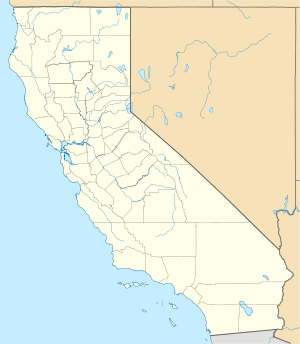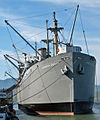SS Jeremiah O'Brien
 SS Jeremiah O'Brien
| |
| History | |
|---|---|
| Name | Jeremiah O'Brien |
| Namesake | Jeremiah O'Brien |
| Owner | War Shipping Administration |
| Operator | Grace Line, Inc. |
| Builder | New England Shipbuilding Corporation |
| Laid down | 6 May 1943 |
| Launched | 19 June 1943 |
| In service | 3 July 1943 |
| Out of service | 7 February 1946 |
| Status | Museum ship |
| General characteristics | |
| Class and type | EC2-S-C1 (Liberty ship) |
| Displacement | 14,245 short tons (12,923 t) |
| Length | 441 ft 6 in (134.57 m) |
| Beam | 57 ft (17 m) |
| Draft | 27 ft 9 in (8.46 m) |
| Propulsion |
|
| Speed | 11 knots (20 km/h; 13 mph) |
| Armament |
|
SS Jeremiah O'Brien | |
| Location | San Francisco, California |
| Built | 1943 |
| Architect | New York Shipbuilding Corp. |
| NRHP reference No. | 78003405 |
| Significant dates | |
| Added to NRHP | 7 June 1978[1] |
| Designated NHL | 14 January 1986[2] |
SS Jeremiah O'Brien is a Liberty ship built during World War II and named for American Revolutionary War ship captain Jeremiah O'Brien (1744–1818).
Now based in San Francisco, she is a rare survivora of the 6,939-ship armada that stormed Normandy on D-Day, 1944.[3]
Jeremiah O'Brien, SS John W. Brown, and SS Hellas Liberty are the only currently operational Liberty ships of the 2,710 built.[4]
History
World War II
The SS Jeremiah O'Brien is a class EC2-S-CI ship, built in just 56 days at the New England Shipbuilding Corporation in South Portland, Maine and launched on 19 June 1943.[5] Deployed in the European Theater of Operations, she made four round-trip convoy crossings of the Atlantic and was part of the Operation Neptune invasion fleet armada on D-Day. Following this she was sent to the Pacific Theater of Operations and saw 16 months of service in both the South Pacific and the Indian Ocean calling at ports in Chile, Peru, New Guinea, the Philippines, India, China, and Australia.
Postwar
The end of the war caused most of the Liberty ships to be removed from service in 1946 and many were subsequently sold to foreign and domestic buyers. Others were retained by the U.S. Maritime Commission for potential reactivation in the event of future military conflicts. Jeremiah O'Brien was mothballed and remained in the National Defense Reserve Fleet in Suisun Bay for 33 years.
Restoration
In the 1970s, however, the idea of preserving an unaltered Liberty Ship began to be developed and, under the sponsorship of Rear Admiral Thomas J. Patterson, USMS (then the Western Regional Director of the U.S. Maritime Administration), the ship was put aside for preservation instead of being sold for scrap. In a 1994 interview printed by the Vintage Preservation magazine "Old Glory," Patterson is alleged to have claimed the ship was steamed to her anchorage in the mothball fleet (unlike the many that were secured as unservicable and towed into storage), and frequently placed at the back of the list for disposal which undoubtedly contributed to her survival.
An all volunteer group, the National Liberty Ship Memorial (NLSM), acquired Jeremiah O'Brien in 1979 for restoration. At that time, she was virtually the last Liberty at the anchorage. Amazingly, those who volunteered to resurrect the mothballed ship (led by Captain Edward MacMichael, NLSM Executive Director and Master) were able to get the antiquated steam plant operating while she remained in Suisun Bay. After more than three decades in mothballs, Jeremiah O'Brien's boilers were lit. The ship left the mothball fleet on 21 May 1980 bound for San Francisco Bay, drydocking, and thousands of hours of restoration work. She was the only Liberty Ship to leave the mothball fleet under her own power.[6]
The Jeremiah O'Brien then moved to Fort Mason on the San Francisco waterfront just to the west of Fisherman's Wharf to become a museum ship dedicated to the men and women who built and sailed with the United States Merchant Marine in World War II. She was named a National Historic Mechanical Engineering Landmark by the American Society of Mechanical Engineers in 1984 and designated a National Historic Landmark in 1986.[7] Licensed to carry tours around San Francisco Bay, it was suggested that the ship be restored to oceangoing specification. After efforts in securing sponsorship, this was accomplished in time for the 50th "D-Day" Anniversary Celebrations in 1994.
50th Anniversary of D-Day
In 1994 the Jeremiah O'Brien steamed through the Golden Gate bound for France. She went down the West Coast, through the Panama Canal, and crossed the Atlantic for the first time since World War II. Stopping first in England she continued on to Normandy, where Jeremiah O'Brien and her crew (a volunteer crew of veteran World War II-era sailors and a few cadets from the California Maritime Academy) participated in the 50th Anniversary of Operation Overlord, the allied invasion that turned the tide of World War II in Europe. She was the only large ship from the original Normandy flotilla to return for the event.
Today
Docked today at Pier 45, she makes several passenger-carrying daylight cruises each year in the San Francisco Bay Area, and occasional voyages to more distant ports such as Seattle and San Diego.
Footage of the ship's engines was used in the 1997 film Titanic to depict the ill-fated ship's own engines.[citation needed]
Gallery
-
At Pier 45, Fisherman's Wharf, San Francisco, California
-
SS Jeremiah O'Brien underway in San Pablo Bay on August 27, 2005, as seen from the aft steering station
-
Polynesian fantasy pinups painted on SS Jeremiah O’Brien's bow for her maiden voyage. Found beneath later paint they were restored during the ship's 1990s restoration
-
Engine room status board seen while underway
See also
- Liberty ship
- List of Liberty ships
- Nash – last surviving D-Day Army ship
- Victory ship
Notes
^a The tugboat Nash, another National Historic Landmark ship located in Oswego, New York, is another survivor of the D-Day fleet.[citation needed]
References
- ^ "National Register Information System". National Register of Historic Places. National Park Service. April 15, 2008.
- ^ "Jeremiah O'Brien (Liberty Ship)". National Historic Landmark summary listing. National Park Service. 2008-06-18. Retrieved 2011-10-19.
- ^ "American Merchant Marine Ships at Normandy in June 1944". U.S. Maritime Service Veterans. Retrieved 2011-10-19.
- ^ Sawyer, L. A.; Mitchell, W. H. (1985). The Liberty Ships (second ed.). London: Lloyd's of London Press Ltd. pp. 229–237.
- ^ "SS Jeremiah O'Brien". World War II in the San Francisco Bay Area. National Park Service. Retrieved 2007-03-22.
- ^ "History of the O'Brien". Archived from the original on July 30, 2011. Retrieved 2011-07-31.
{{cite web}}: Unknown parameter|deadurl=ignored (|url-status=suggested) (help) - ^ National Park Service: Determining the Facts
- Butowsky, Harry A. (May 1985). "National Register of Historic Places Inventory—Nomination Form / SS Jeremiah O'Brien" (pdf). National Park Service. Retrieved 2012-09-16.
- "Accompanying Photos" (pdf). National Park Service. Retrieved 2012-09-16.
External links
- "National Liberty Ship Memorial (SS Jeremiah O'Brien official site)".
- "Photo site of the Jeremiah O'Brien".
- "Jeremiah O'Brien Photo Gallery".
- "SS Jeremiah O'Brien". Historic Naval Ships Association.
- Liberty ships
- Museum ships in San Francisco, California
- Freighters
- 1943 ships
- Ships built in Portland, Maine
- Ships on the National Register of Historic Places in California
- World War II merchant ships of the United States
- Merchant marine
- Golden Gate National Recreation Area
- Military and war museums in California
- National Historic Landmarks in the San Francisco Bay Area
- National Register of Historic Places in San Francisco, California
- Battle of the Atlantic
- Naval battles of World War II involving the United States
- Naval battles of World War II involving the United Kingdom
- Naval battles of World War II involving Germany
- American Theater of World War II
- World War II on the National Register of Historic Places





